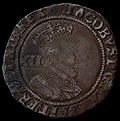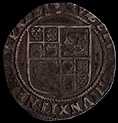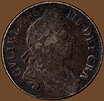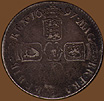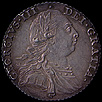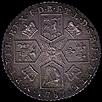British Silver Coinage
SIXPENCE
obverse |
|
reverse |
| |||
Sixpence 1697 William III W36D-200
Obverse: GVLIELMVS . III DEI GRA .
Reverse: MAG BR . FRA ET . HIB REX
.16 97 .
Weight: 45.0 g (2.91 grams) Diameter: 21.1 mm
Comments: This example shows the first of three obverse portraits with the mintmark E below, for the Exeter mint. The reverse shows the third reverse which can be distinguished from the second reverse (also used in 1697), for in the third reverse the four crowns are narrower than the shields while on the second reverse they are of equal width.
Provenance: Donated to Notre Dame in 1887 as part of a 2,300 item coin collection (see: The Notre Dame Scholastic, vol. 21 (September 1887) 45.
obverse |
|
reverse |
| |||
Sixpence 1787 George III G36D-005
Obverse: GEORGIVS . III . DEI . GRATIA .
Reverse: M . B . F . ET . H . REX . F . D . B . ET . L . D . S . R
. I . A . T . ET . E . 1787 .
Weight: 45.5 g (2.95 grams) Diameter: 20.8 mm
Comments: This is the first year of issue of the George III sixpence. The last previous issue had been 29 years earlier by George II in 1758, consequently most sixpence were well worn by 1787 so a large quantity were minted. After many examples had been struck it was discovered a semée of hearts had been inadvertently left out of the arms of Brunswick in the Hannover shield (to the left, opposite the French arms, there should be hearts around the upright lion located to the right of and above the running horse). The die was then revised. The example shown here displays the original die without the hearts. A translation of the highly abbreviated Latin legend on the reverse is: King of Great Britain, France and Ireland, Defender of the Faith, Duke of Brunswick and Lueneburg, Arch-Treasurer and Elector of the Holy Roman Empire. The 1787 issue was the last larger sized sixpence. No more were sixpence were minted until 1816 when George III reduced the size of the coin.
Provenance: Donated to Notre Dame in 1887 as part of a 2,300 item coin collection (see: The Notre Dame Scholastic, vol. 21 (September 1887) 45.
SHILLINGS
obverse |
|
reverse |
| |||
Shilling 1604-1619 James I Hammered Shilling J1SH-020
Obverse: IACOBVS . D . G . MAG . BRIT . FRA . ET . HIB . REX . [rubbed mintmark] .
Reverse: QVAE . DEVS . CONIVNXIT . NEMO . SEPARET [mintmark] .
Weight: 87.9 g (5.69 grams) Diameter: 29.6 mm
Comments: This is an example of a hammered shilling from the second coinage of James I, dating to to 1604-1619. It appears to be the fourth of six different bust used on his coinage, specific dates is based on the mintmak which is worn on this example. The obverse shows the bust of the king facing right with XII for the denomination. The motto translates as James by the grace of God King of Great Britain, France and Ireland. On the reverse is the royal shield and a legend that translates as: What God has joined together let no one seperate.
Provenance: Donated to Notre Dame in 1887 as part of a 2,300 item coin collection (see: The Notre Dame Scholastic, vol. 21 (September 1887) 45.
obverse |
|
reverse |
| |||
Shilling 1697 William III W3SH-230
Obverse: GVLIELMVS . III . DEI . GRA
Reverse: MAG BR . FRA ET . HIB REX
. 16 97 .
Weight: 88.3 g (5.72 grams) Diameter: 25.2 mm
Comments: This example displays the fourth of six portraits used on the William III shilling series. There are about thirty variants for 1697, the present example appears to be the standard issue without mintmark, transposed shields or legend variation.
Provenance: Donated to Notre Dame in 1887 as part of a 2,300 item coin collection (see: The Notre Dame Scholastic, vol. 21 (September 1887) 45.
obverse |
|
reverse |
| |||
Shilling 1787 George III G3SH-010
Obverse: GEORGIVS . III . DEI . GRATIA .
Reverse: M . B . F . ET . H . REX . F . D . B . ET . L . D . S . R
. I . A . ET . E . 17 87 .
Weight: 93.1 g (6.03 grams) Diameter: 25.4 mm
Comments: This is the first large scale issue of the George III shilling. George II's final issues had been produced in 1751 and 1758, there was also a limited minting of shillings in 1763 by the Earl of Northumberland upon his appointment as Lord Lieutenant of Ireland. After 1787 some shilling were minted in 1798 but this issue was declared illegal and most examples were melted down; the next regular issue was in 1816.
Like the sixpence, most shillings had been well worn by 1787 so a large quantity were minted. After many examples had been struck it was discovered a semée of hearts had been inadvertently left out of the arms of Brunswick in the Hannover shield (to the left, opposite the French arms, there should be hearts around the upright lion located to the right of and above the running horse). The die was then revised. The example shown here displays the original die without the hearts. It has the second of four obverse portraits used by George and the second of five reverse designs (the first obverse and reverse design are found on the rare 'Northumberland' shilling of 1763). A translation of the highly abbreviated Latin legend on the reverse is: King of Great Britain, France and Ireland, Defender of the Faith, Duke of Brunswick and Lueneburg, Arch-Treasurer and Elector of the Holy Roman Empire.
Provenance: From the Robert H. Gore, Jr. Numismatic Collection.
| British Silver: p. 1 | Section Contents | French Coinage |
|
For viewing tips and information on optimal computer settings click
here.
For questions or comments contact Special Collections by: |




